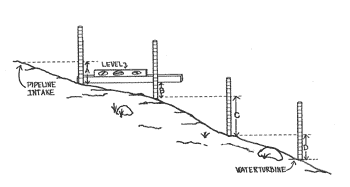Part 2: Planning Your Own Hydro System
Bookmark this page (Ctrl+D)
![]() View/Print PDF Version
View/Print PDF Version
Guide Navigation
Measuring Head and Flow
Now that you have a basic understanding of hydro system components, it’s time to begin assessing your own hydro power potential.
The Four Things You Need to Know

Before you can begin planning your systems or estimating how much power you'll produce, you'll need to make four essential measurements:
- Head (the vertical distance between your intake and turbine)
- Flow (how much water comes down the stream)
- Pipeline (Penstock) length
- Transmission Line length
In this section, we'll discuss how to make these measurements and how they affect the design and efficiency of your hydro system.
Measuring Head and Flow
HEAD and FLOW are the two most important facts you need to know about your site. You simply cannot move forward without these measurements.
Your Head and Flow will determine everything about your hydro system – pipeline size, turbine type, rotational speed, generator size – everything. Even rough cost estimates will be impossible until you’ve measured Head and Flow.
Also keep in mind that accuracy is important. Unless your measurements are accurate, you could end up with a hydro system designed to the wrong specs, producing less power at a higher cost-per-watt than would otherwise be possible.
Measuring Head
HEAD is pressure, created by the difference in elevation between the intake of your pipeline, and your water turbine. Head can be measured as vertical distance (feet or meters) or as pressure (pounds per square inch, newtons per square meter, etc.). Regardless of the size of your stream, higher HEAD will produce greater pressure – and therefore power – at the turbine.
The following conversions may be helpful:
- 1 vertical foot = 0.433 pounds per square inch (psi) pressure
- 1 psi = 2.31 vertical feet
Accuracy is critical when measuring HEAD. It not only affects power, but also determines the type of turbine to use (such as a Francis or Pelton design), as well as the hydrodynamic design of the turbine buckets or blades. An altimeter can be useful in estimating Head for preliminary site evaluation, but should not be used for the final measurement. It is quite common for low-cost barometric altimeters to reflect errors of 150 feet or more, even when calibrated. GPS altimeters are often even less accurate.
There are two accurate methods for measuring HEAD: direct distance measurement, and water pressure.
Direct Distance Measurement

You can use a surveyor’s transit, a contractor's level on a tripod, or a level taped to a straight board to measure head. You will also require a pole with graduated measurements. (A measuring tape affixed to a 20' section of PVC pipe works well.) Direct measurement requires an assistant.
As shown in the diagram, make a series of vertical measurements using the transit level and the vertical measuring pole. Make sure each transit setup is exactly level, and ensure the measuring pole is vertical. Keep detailed notes at each step, and then add up the series of measurements (A,B,C,D,etc.) to find total HEAD.
Water Pressure Measurement
If the distance is short enough, you can use one or more garden hoses to measure Head. This method relies on the constant that each vertical foot of HEAD creates 0.433 psi of water pressure. (10 vertical feet would create 4.33 psi.) By measuring the pressure in the hose, you can calculate the elevation change of your system.
Run the hose (or hoses) from your proposed intake site to your proposed turbine location. If you attach multiple hoses together, ensure each connection is tight and leak-free. Attach an accurate pressure meter to the bottom end of the hose and completely fill the hose with water. Make sure there are no high spots in the hose that could trap air.
If necessary, you can measure total HEAD over longer distances by moving the hose(s) and taking multiple readings. Keep in mind, however, that there is less than a half-psi difference for every vertical foot. Except for very steep hillsides, even a hundred foot hose may drop only a few vertical feet. The chance for error significantly increases with a series of low-Head readings. Use the longest possible hose, along with a highly accurate pressure meter, to measure HEAD. The pressure meter must be graduated so that measurements are taken in the middle of the pressure gauge's range. Don't use a 0 - 800 PSI gauge to measure 5 -15 PSI pressure. Select instead a 0 - 30 PSI gauge.
Gross Head vs. Net Head
By recording these actual measurements, you have determined Gross Head. As described later in Computing Net Head, however, the effective Head at the nozzle is actually lower when water begins to flow, due to pipeline (penstock) friction. A properly designed pipeline will yield a Net Head of about 85%-90% of the Gross Head you measured.